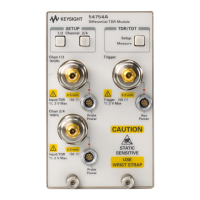TDR Fundamentals
Step Reflection Testing
9-12
A similar analysis is possible for the case of the parallel R-C termination. At
time zero, the load appears as a short circuit since the capacitor will not accept
a sudden change in voltage. Therefore ρ = - 1 when t = 0. After some time,
however, voltage builds up on C and its impedance rises. At t = ∞, the capacitor
is effectively an open circuit:
The resistance seen by the capacitor is Z
o
in parallel with R, and therefore the
time constant of the exponential transition of e
r
(t) is:
The two remaining cases can be treated in exactly the same way. The results
of this analysis are summarized in Figure 9-7.
Measuring the Time Constant of the Reflected Wave from Complex
Loads
When one encounters a transmission line terminated in a complex impedance,
determining the element values comprising Z
L
involves measuring two things:
1. Either e
r
(t) at t = 0 or at t = ∞
and
2. The time constant of the exponential transition from e
r
(0) to e
r
(∞).
Number 1 is a straight forward procedure from the information given in
Figure 9-7. Number 2 is most conveniently done by measuring the time to
complete one half of the exponential transition from e
r
(0) to e
r
(∞). The time
for this to occur corresponds to 0.69 t, where t denotes the time constant of the
exponential. Adjusting the vertical sensitivity of the oscilloscope in the TDR
system so that the exponential portion of the reflected wave fills the full vertical
dimension of the graticule makes this measurement very easy (Figure 9-8).
Z
L
R=
ρ∴
RZ
o
–
RZ
o
+
---------------=
Z
o
R
Z
o
R+
---------------
C

